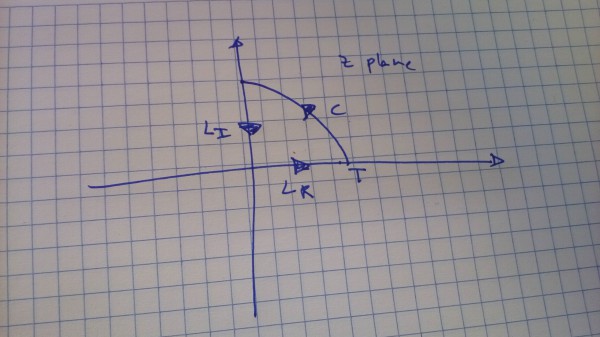I have engaged in the derivation of the Euclidean path integral performing the Wick rotation in full detail. Unfortunately I am facing some trouble and I come here seeking advice.
For simplicity I work on 1 dimension and in god-given units. The amplitude for a spinless particle of unit mass to go from the point xi to the point xf in a time interval T is given by
∫D[x]ei∫T0dtL(t)
=∫D[x]ei∫T0dt{12(dxdt)2−V(x)}
let's focus on the integral on the exponent
∫T0dt{12(dxdt)2−V(x)}
to get the Euclidean path integral i gotta Wick-rotate this. In order to do this i write the Lagrangian for a general complex variable
z=t+iβ
L(z)=12(dxdz)2−V(x(z))
and I consider the contour

I also assume (maybe naively) that there is no pole in bothering us for L(z). Cauchy's theorem allows us to write
∫LRdzL(z)+∫LIdzL(z)+∫CdzL(z)=0
Let's go one by one. For
LR I parametrize
z(t)=t
∫LRdzL(z)=∫T0dt{12(dxdt)2−V(x)}
For
LI I have
z(β)=iβ
∫LIdzL(z)=−i∫T0dβ{12(dxidβ)2−V(x)}
for
C i have
z(ϕ)=Teiϕ
∫CdzL(z)=iT∫π/20dϕeiϕ{12(dxiTeiϕdϕ)2−V(x)}
by Cauchy's theorem then
∫T0dt{12(dxdt)2−V(x)}=i∫T0dβ{−12(dxdβ)2−V(x)}−∫CdzL(z)
if I plug this in the path integral I get
∫D[x]ei∫T0dt{12(dxdt)2−V(x)}
=∫D[x]e∫T0dβ{12(dxdβ)2+V(x)}e−i∫CdzL(z)
and you see the problem here. I lack a minus sign in the first exponential, and the second one shouldn't be there. Maybe I can get the correct expression by manipulating the second exponential but I right now I don't see how. Can anyone right my wrongs?
 Q&A (4906)
Q&A (4906) Reviews (205)
Reviews (205) Meta (440)
Meta (440) Q&A (4906)
Q&A (4906) Reviews (205)
Reviews (205) Meta (440)
Meta (440)